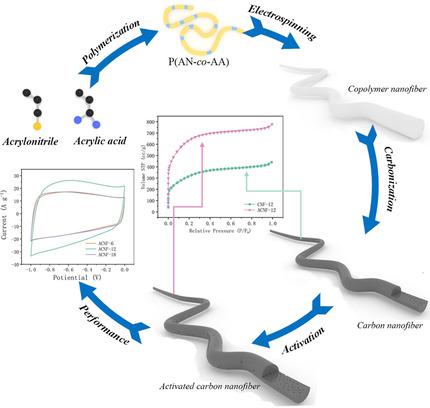当前位置:
X-MOL 学术
›
Chem. Eur. J.
›
论文详情
Our official English website, www.x-mol.net, welcomes your
feedback! (Note: you will need to create a separate account there.)
Microporous Carbon Nanofibers Derived from Poly(acrylonitrile‐co‐acrylic acid) for High‐Performance Supercapacitors
Chemistry - A European Journal ( IF 3.9 ) Pub Date : 2020-02-25 , DOI: 10.1002/chem.201904563 Jiye Li 1 , Xin Song 1 , Weimiao Zhang 1 , Hao Xu 1 , Teng Guo 1 , Xu Zhang 1 , Jiefeng Gao 1 , Huan Pang 1 , Huaiguo Xue 1
Chemistry - A European Journal ( IF 3.9 ) Pub Date : 2020-02-25 , DOI: 10.1002/chem.201904563 Jiye Li 1 , Xin Song 1 , Weimiao Zhang 1 , Hao Xu 1 , Teng Guo 1 , Xu Zhang 1 , Jiefeng Gao 1 , Huan Pang 1 , Huaiguo Xue 1
Affiliation

|
Carbon nanofiber (CNF)‐based supercapacitors have promising applications in the field of energy storage. It is desirable, but remains challenging, to develop CNF electrode materials with large specific surface area (SSA), high specific capacitance (SC), and high power density, as well as excellent cycling stability and high reliability. Herein, acrylonitrile–acrylic acid copolymer P(AN‐co‐AA) was synthesized for the preparation of nitrogen‐doped microporous CNFs. Thermal degradation of the AA segment leads to the formation of micropores that are distributed not only on the CNF surface, but also inside the material. The microporous structure and nitrogen content can be manipulated at the molecular level by adjusting the weight ratio between AN and AA, and the SSA and SC could reach as high as 1099 m2 g−1 and 156 F g−1, respectively. After KOH activation, the activated CNFs have an extremely high SSA of 2117 m2 g−1 and SC of 320 F g−1, which are among the highest values ever reported for electric double‐layer supercapacitors with an alkaline electrolyte. Furthermore, the capacitance retention, which can be maintained at 99 % even after 16 000 cyclic tests, reveals outstanding durability and repeatability.
中文翻译:

源自聚丙烯腈-丙烯酸的微孔碳纳米纤维,用于高性能超级电容器
基于碳纳米纤维(CNF)的超级电容器在储能领域具有广阔的应用前景。期望但仍然具有挑战性的是,开发具有大的比表面积(SSA),高的比电容(SC)和高的功率密度以及优异的循环稳定性和高可靠性的CNF电极材料。在此,合成了丙烯腈-丙烯酸共聚物P(AN- co- AA)以制备氮掺杂的微孔CNF。AA链段的热降解会导致形成不仅分布在CNF表面而且分布在材料内部的微孔。通过调节AN和AA之间的重量比,可以在分子水平上控制微孔结构和氮含量,SSA和SC可高达1099 m分别为2 g -1和156 F g -1。KOH活化后,活化的CNF具有2117 m 2 g -1的极高SSA和320 F g -1的SC ,这是有碱性双电超级电容器报道的最高值。此外,即使在进行16 000次循环测试后,电容保持率也可以保持在99%,显示出出色的耐用性和可重复性。
更新日期:2020-02-25
中文翻译:

源自聚丙烯腈-丙烯酸的微孔碳纳米纤维,用于高性能超级电容器
基于碳纳米纤维(CNF)的超级电容器在储能领域具有广阔的应用前景。期望但仍然具有挑战性的是,开发具有大的比表面积(SSA),高的比电容(SC)和高的功率密度以及优异的循环稳定性和高可靠性的CNF电极材料。在此,合成了丙烯腈-丙烯酸共聚物P(AN- co- AA)以制备氮掺杂的微孔CNF。AA链段的热降解会导致形成不仅分布在CNF表面而且分布在材料内部的微孔。通过调节AN和AA之间的重量比,可以在分子水平上控制微孔结构和氮含量,SSA和SC可高达1099 m分别为2 g -1和156 F g -1。KOH活化后,活化的CNF具有2117 m 2 g -1的极高SSA和320 F g -1的SC ,这是有碱性双电超级电容器报道的最高值。此外,即使在进行16 000次循环测试后,电容保持率也可以保持在99%,显示出出色的耐用性和可重复性。

















































 京公网安备 11010802027423号
京公网安备 11010802027423号